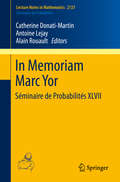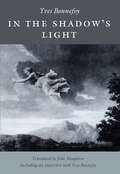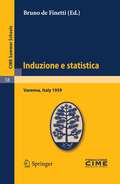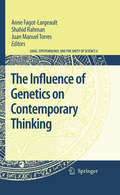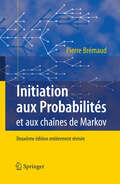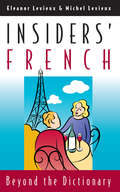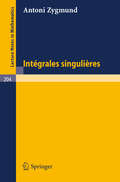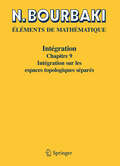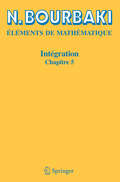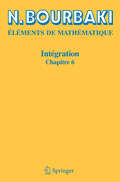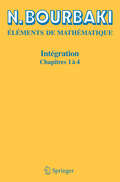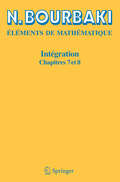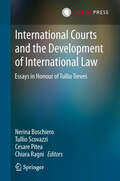- Table View
- List View
Impulse für eine europäische Harmonisierung des Urheberrechts / Perspectives d'harmonisation du droit d'auteur en Europe: Urheberrecht im deutsch-französischen Dialog / Rencontres franco-allemandes (MPI Studies on Intellectual Property and Competition Law #2)
by T. Engelhardt G. Hansen K. Markowsk S. Nérisson V. StérinDeutsch-französische Kooperation: Das Max-Planck-Institut für Geistiges Eigentum lotet hier gemeinsam mit dem Institut de Recherche en Propriété Intellectuelle Henri-Desbois das Thema Urheberrecht auf europäischer Ebene aus. Der vorliegende Band enthält die ideenreichen Beiträge und Lösungsvorschläge namhafter Urheberrechtsexperten beider Länder zur Harmonisierung des Urheberrechts in Europa. (Vortragsreihe München-Paris, 09/2004 bis 01/2006).
In Memoriam Marc Yor - Séminaire de Probabilités XLVII (Lecture Notes in Mathematics #2137)
by Catherine Donati-Martin Antoine Lejay Alain RouaultThis volume is dedicated to the memory of Marc Yor, who passed away in 2014. The invited contributions by his collaborators and former students bear testament to the value and diversity of his work and of his research focus, which covered broad areas of probability theory. The volume also provides personal recollections about him, and an article on his essential role concerning the Doeblin documents.With contributions by P. Salminen, J-Y. Yen & M. Yor; J. Warren; T. Funaki; J. Pitman& W. Tang; J-F. Le Gall; L. Alili, P. Graczyk & T. Zak; K. Yano & Y. Yano; D. Bakry & O. Zribi; A. Aksamit, T. Choulli & M. Jeanblanc; J. Pitman; J. Obloj, P. Spoida & N. Touzi; P. Biane; J. Najnudel; P. Fitzsimmons, Y. Le Jan & J. Rosen; L.C.G. Rogers & M. Duembgen; E. Azmoodeh, G. Peccati & G. Poly, timP-L Méliot, A. Nikeghbali; P. Baldi; N. Demni, A. Rouault & M. Zani; N. O'Connell; N. Ikeda & H. Matsumoto; A. Comtet & Y. Tourigny; P. Bougerol; L. Chaumont; L. Devroye & G. Letac; D. Stroock and M. Emery.
In Memoriam Paul-André Meyer - Séminaire de Probabilités XXXIX (Lecture Notes in Mathematics #1874)
by Marc Yor Michel ÉmeryThe 39th volume of Séminaire de Probabilités is a tribute to the memory of Paul André Meyer. His life and achievements are recalled in this book, and tributes are paid by his friends and colleagues. This volume also contains mathematical contributions to classical and quantum stochastic calculus, the theory of processes, martingales and their applications to mathematical finance and Brownian motion. These contributions provide an overview on the current trends of stochastic calculus.
In the Shadow's Light
by Yves BonnefoyThis bilingual edition of the contemporary master's fifth work, Ce qui fut sans lumi, re, will delight, engage, and stir all lovers of poetry. Included here is an extensive new interview with the poet in English translation. "Included here is a very helpful and touchingly personal interview with the poet. . . . For readers with no prior knowledge of Bonnefoy's work, this volume would be an excellent place to start."—Stephen Romer, Times Literary Supplement
Induzione e statistica: Lectures given at a Summer School of the Centro Internazionale Matematico Estivo (C.I.M.E.) held in Varenna (Como), Italy, June 1-10, 1959 (C.I.M.E. Summer Schools #18)
by Bruno De FinettiB.De Finetti: La probabilità e la statistica nei rapporti con l´induzione, secondo i diversi punti di vista.- L.J. Savage: La probabilità soggettiva nei problemi pratici della statistica.- L. Daboni: Sulle catene di Markoff.- S. Lombardini: Decisoni economiche in condizioni di incertezza.- A. Longo: La R.O. (Ricerca Operativa).
The Influence of Genetics on Contemporary Thinking (Logic, Epistemology, and the Unity of Science #6)
by Anne Fagot-Largeault Shahid Rahman Juan Manuel TorresThis interdisciplinary volume reflects on the effects of recent discoveries in genetics on a broad range of scientific fields. It shows the way in which those discoveries influence genetics itself and many other fields, and explains the impact of genetics on contemporary culture. The volume contains the most recent views of the Nobel Laureate François Jacob on genetics and the nature of living things.
Initiation aux Probabilités: et aux chaînes de Markov
by Pierre BrémaudCette introduction aux concepts probabilistes et au calcul des probabilités s'adresse aux élèves-ingénieurs ou aux étudiants qui ne se destinent pas a priori à une carrière en mathématiques. La présentation, bien qu'utilisant le formalisme moderne, ne fait donc pas appel à une connaissance préalable de la Théorie de la Mesure et de l'Intégration. En revanche, l'auteur insiste tout au long du livre sur l'aspect essentiel de la modélisation, à l'aide d'exercises variés en génétique (processus de branchement) en théorie des communicaitons (transmission de données, codage), en théorie du signal (filtre de Kalman-Bucy), en recherche opérationnelle (fils d'attente) en statistique (tests d'hypothèses), etc. Une dernière caractéristique importante de ce livre est la présence d'une centaine d'exercices avec solutions détaillées.
Insiders' French: Beyond the Dictionary
by Eleanor Levieux Michel LevieuxIf you had been living in France in the 1990s, the language you would have heard on the radio and television or seen in the newspapers would be far removed from the French language of ten or twenty years ago. The country and its language have changed tremendously in a relatively short period of time, and, as a result, English speakers with a grounding in French can still find themselves struggling to understand terms commonly encountered in contemporary French society. Luckily, Eleanor and Michel Levieux now bring us up to date with their Insiders' French, an utterly entertaining and informative guide to the language of the "new France." This "new France" is a country poised to experience the European single currency but uncertain about being part of Europe. It is hooked on fast food but ambivalent about the country where it originated. France today has record unemployment and an increasingly controversial immigrant population. Clearly, given the rapidly changing conditions and lifestyles, conventional French dictionaries alone cannot completely inform readers and visitors. Insiders' French offers a solution to the incomprehension, a unique handbook in which you'll find the language of European union, the space program, abortion and women's rights, high-tech industries, and health care, among other topics. Entries proceed by association of ideas and related terms, with extensive cross-referencing, while still being alphabetized for easy reference like a standard dictionary. Cartoons from major French journals add to your understanding and enjoyment. Insiders' French opens up the secret territory of French politics and culture that is often not understood by visitors or students, and it does so with wit and verve—qualities that remain in the French language despite its recent changes.
Insiders' French: Beyond the Dictionary (Nature Of Human Society Ser.)
by Eleanor Levieux Michel LevieuxIf you had been living in France in the 1990s, the language you would have heard on the radio and television or seen in the newspapers would be far removed from the French language of ten or twenty years ago. The country and its language have changed tremendously in a relatively short period of time, and, as a result, English speakers with a grounding in French can still find themselves struggling to understand terms commonly encountered in contemporary French society. Luckily, Eleanor and Michel Levieux now bring us up to date with their Insiders' French, an utterly entertaining and informative guide to the language of the "new France." This "new France" is a country poised to experience the European single currency but uncertain about being part of Europe. It is hooked on fast food but ambivalent about the country where it originated. France today has record unemployment and an increasingly controversial immigrant population. Clearly, given the rapidly changing conditions and lifestyles, conventional French dictionaries alone cannot completely inform readers and visitors. Insiders' French offers a solution to the incomprehension, a unique handbook in which you'll find the language of European union, the space program, abortion and women's rights, high-tech industries, and health care, among other topics. Entries proceed by association of ideas and related terms, with extensive cross-referencing, while still being alphabetized for easy reference like a standard dictionary. Cartoons from major French journals add to your understanding and enjoyment. Insiders' French opens up the secret territory of French politics and culture that is often not understood by visitors or students, and it does so with wit and verve—qualities that remain in the French language despite its recent changes.
Insiders' French: Beyond the Dictionary (Nature Of Human Society Ser.)
by Eleanor Levieux Michel LevieuxIf you had been living in France in the 1990s, the language you would have heard on the radio and television or seen in the newspapers would be far removed from the French language of ten or twenty years ago. The country and its language have changed tremendously in a relatively short period of time, and, as a result, English speakers with a grounding in French can still find themselves struggling to understand terms commonly encountered in contemporary French society. Luckily, Eleanor and Michel Levieux now bring us up to date with their Insiders' French, an utterly entertaining and informative guide to the language of the "new France." This "new France" is a country poised to experience the European single currency but uncertain about being part of Europe. It is hooked on fast food but ambivalent about the country where it originated. France today has record unemployment and an increasingly controversial immigrant population. Clearly, given the rapidly changing conditions and lifestyles, conventional French dictionaries alone cannot completely inform readers and visitors. Insiders' French offers a solution to the incomprehension, a unique handbook in which you'll find the language of European union, the space program, abortion and women's rights, high-tech industries, and health care, among other topics. Entries proceed by association of ideas and related terms, with extensive cross-referencing, while still being alphabetized for easy reference like a standard dictionary. Cartoons from major French journals add to your understanding and enjoyment. Insiders' French opens up the secret territory of French politics and culture that is often not understood by visitors or students, and it does so with wit and verve—qualities that remain in the French language despite its recent changes.
Insiders' French: Beyond the Dictionary
by Eleanor Levieux Michel LevieuxIf you had been living in France in the 1990s, the language you would have heard on the radio and television or seen in the newspapers would be far removed from the French language of ten or twenty years ago. The country and its language have changed tremendously in a relatively short period of time, and, as a result, English speakers with a grounding in French can still find themselves struggling to understand terms commonly encountered in contemporary French society. Luckily, Eleanor and Michel Levieux now bring us up to date with their Insiders' French, an utterly entertaining and informative guide to the language of the "new France." This "new France" is a country poised to experience the European single currency but uncertain about being part of Europe. It is hooked on fast food but ambivalent about the country where it originated. France today has record unemployment and an increasingly controversial immigrant population. Clearly, given the rapidly changing conditions and lifestyles, conventional French dictionaries alone cannot completely inform readers and visitors. Insiders' French offers a solution to the incomprehension, a unique handbook in which you'll find the language of European union, the space program, abortion and women's rights, high-tech industries, and health care, among other topics. Entries proceed by association of ideas and related terms, with extensive cross-referencing, while still being alphabetized for easy reference like a standard dictionary. Cartoons from major French journals add to your understanding and enjoyment. Insiders' French opens up the secret territory of French politics and culture that is often not understood by visitors or students, and it does so with wit and verve—qualities that remain in the French language despite its recent changes.
Insiders' French: Beyond the Dictionary
by Eleanor Levieux Michel LevieuxIf you had been living in France in the 1990s, the language you would have heard on the radio and television or seen in the newspapers would be far removed from the French language of ten or twenty years ago. The country and its language have changed tremendously in a relatively short period of time, and, as a result, English speakers with a grounding in French can still find themselves struggling to understand terms commonly encountered in contemporary French society. Luckily, Eleanor and Michel Levieux now bring us up to date with their Insiders' French, an utterly entertaining and informative guide to the language of the "new France." This "new France" is a country poised to experience the European single currency but uncertain about being part of Europe. It is hooked on fast food but ambivalent about the country where it originated. France today has record unemployment and an increasingly controversial immigrant population. Clearly, given the rapidly changing conditions and lifestyles, conventional French dictionaries alone cannot completely inform readers and visitors. Insiders' French offers a solution to the incomprehension, a unique handbook in which you'll find the language of European union, the space program, abortion and women's rights, high-tech industries, and health care, among other topics. Entries proceed by association of ideas and related terms, with extensive cross-referencing, while still being alphabetized for easy reference like a standard dictionary. Cartoons from major French journals add to your understanding and enjoyment. Insiders' French opens up the secret territory of French politics and culture that is often not understood by visitors or students, and it does so with wit and verve—qualities that remain in the French language despite its recent changes.
Insiders' French: Beyond the Dictionary
by Eleanor Levieux Michel LevieuxIf you had been living in France in the 1990s, the language you would have heard on the radio and television or seen in the newspapers would be far removed from the French language of ten or twenty years ago. The country and its language have changed tremendously in a relatively short period of time, and, as a result, English speakers with a grounding in French can still find themselves struggling to understand terms commonly encountered in contemporary French society. Luckily, Eleanor and Michel Levieux now bring us up to date with their Insiders' French, an utterly entertaining and informative guide to the language of the "new France." This "new France" is a country poised to experience the European single currency but uncertain about being part of Europe. It is hooked on fast food but ambivalent about the country where it originated. France today has record unemployment and an increasingly controversial immigrant population. Clearly, given the rapidly changing conditions and lifestyles, conventional French dictionaries alone cannot completely inform readers and visitors. Insiders' French offers a solution to the incomprehension, a unique handbook in which you'll find the language of European union, the space program, abortion and women's rights, high-tech industries, and health care, among other topics. Entries proceed by association of ideas and related terms, with extensive cross-referencing, while still being alphabetized for easy reference like a standard dictionary. Cartoons from major French journals add to your understanding and enjoyment. Insiders' French opens up the secret territory of French politics and culture that is often not understood by visitors or students, and it does so with wit and verve—qualities that remain in the French language despite its recent changes.
Instability of Continuous Systems: Symposium Herrenalb (Germany) September 8–12, 1969 (IUTAM Symposia)
by Horst LeipholzUntil recently there was no uniform stability theory. Different approaches to stability problems had been developed in the different branches of mechanics. In the field of elasticity, it was mainly the so called static method and energy method which were used, while in the field of dynamics it was the kinetic method, which found its perfect expression in the theory of Liapunov. During the last few decades there has been a rapid development in the general theory of stability, stimulated, for example, by the investigations of H. ZIEGLER on elastic systems subject to non-conservative loads, and by the problems arising in aeroelasticity which are closely related to those introduced by ZIEGLER. The need was felt for kinetic methods which could also be used in investigating the stability of deformable systems. Efforts were made to adapt such methods, already known and developed in the stability theory of rigid systems, for application in the stability theory of continuous systems. During the last ten years interest was focused mainly on the application of a generalized Liapunov method to stability problems of continuous systems. All this was done in attempts to unify the various approaches to stability theory. It was with the idea of encouraging such a tendency, establishing to what extent a uniform physical and mathematical foundation already existed for stability theory in all branches of mechanics, and stimulating the further deve lopment of a common stability theory, that a IUTAM-Symposium was devoted to this topic.
Integrales Exponentielles: Developpements Asymptotiques, Proprietes Lagrangiennes (Lecture Notes in Mathematics #937)
by E. CombetIntégration: Chapitre 9 Intégration sur les espaces topologiques séparés
by N. BourbakiLes Éléments de mathématique de Nicolas Bourbaki ont pour objet une présentation rigoureuse, systématique et sans prérequis des mathématiques depuis leurs fondements. Ce neuvième chapitre du Livre d’Intégration, sixième Livre des éléments de mathématique, est consacré a l’intégration dans les espaces topologiques séparés non nécessairement localement compacts, ce qui permet d’étendre la théorie de la transformation de Fourier aux espaces vectoriels localement convexes. Ce chapitre introduit également la mesure de Wiener qui intervient dans le cadre de l’étude du movement brownian. Il contient une note historique. Ce volume a été publié en 1969.
Intégration: Chapitre 5
by N. BourbakiIntégration 5 Les Éléments de mathématique de Nicolas Bourbaki ont pour objet une présentation rigoureuse, systématique et sans prérequis des mathématiques depuis leurs fondements. Ce cinquième chaptire du Livre d’Intégration, sixième Livre des éléments de mathématique, traite notamment d’une generalisation du théorème des Lebesgue-Fubini et du théorème de Lebesque-Nikodym. Il contient également des notes historiques. Ce volume est une réimpression de l’édition de 1967.
Intégration: Chapitre 6
by N. BourbakiLes Éléments de mathématique de Nicolas Bourbaki ont pour objet une présentation rigoureuse, systématique et sans prérequis des mathématiques depuis leurs fondements. Ce sixième chaptire du Livre d’Intégration, sixième Livre des éléments de mathématique, étend la notion d’intégration à des mesure à valeurs dans des espaces vectoriels de Hausdorff localement convexes. Il contient également une note historique. Ce volume est une réimpression de l’édition de 1959.
Intégration: Chapitres 1 à 4
by N. BourbakiCe premier volume du Livre d’Intégration, sixième Livre du traité, est consacré aux fondements de la théorie de l’intégration, il comprend les chapitres : Inégalités de convexité ; Espaces de Riesz ; Mesures sur les espaces localement compacts ; Prolongement d’une mesure. Espaces Lp.
Intégration: Chapitres 7 à 8
by N. BourbakiCe volume du Livre d’Intégration, sixième Livre du traité, traite de l’intégration sur les groupes localement compacts et de ses applications. Les notions introduites, telles que les mesures de Haar et le produit de convolution, sont à la base de l’analyse harmonique. Il comprend les chapitres : -1. Mesure de Haar ; -2. Convolution et représentations.
Intellectual Journeys: The Translation of Ideas in Enlightenment England, France and Ireland (Oxford University Studies in the Enlightenment #2013:12)
The exchange of ideas between nations during the Enlightenment was greatly facilitated by cultural ventures, commercial enterprise and scientific collaboration. But how were they exchanged? What were the effects of these exchanges on the idea or artefact being transferred?Focussing on contact between England, France and Ireland, a team of specialists explores the translation, appropriation and circulation of cultural products and scientific ideas during the Enlightenment. Through analysis of literary and artistic works, periodicals and official writings contributors uncover:the key role played by literary translators and how they adapted, naturalized and sometimes distorted plays and novels to conform to new cultural norms;the effects of eighteenth-century anglomania, and how this was manifested in French art;how the vagaries of international politics and conflict affected both the cultural products themselves and the modes of dissemination;how religious censorship engendered new Irish Catholic and French Huguenot diasporas, with their particular intellectual pursuits and networks of exchange;the significance of newspapers and periodicals in disseminating new knowledge and often radical philosophical ideas.By exploring both broad areas of cultural activity and precise examples of cultural transfer, contributors to Intellectual journeys reveal the range and complexity of intellectual exchange and its role in the formation of a truly transnational Enlightenment.
The Interdisciplinary Century: tensions and convergences in eighteen-century art, history and literature (Oxford University Studies in the Enlightenment #2005:04)
by Julia V. DouthwaiteJudging by most contemporary accounts, the virtues of cross-disciplinary research, teaching and scholarship are above reproach. Conference organisers announce with pride that ‘l’interdisciplinarité a porté ses fruits’; governments and universities sponsor ever-growing numbers of interdisciplinary research teams. Such activity is especially pertinent to eighteenth-century studies. The Republic of Letters inspired scholars, scientists, artists, and writers to engage in spirited, multilingual and long-term correspondence with colleagues throughout Europe. As many contributors to this timely and provocative volume argue, a certain kind of interdisciplinarity is required for any consideration of eighteenth-century topics.But what impact has this enthusiasm for interdisciplinarity had on our understanding of objects, monuments, texts, and events of the past? Born of an intense series of debates, this volume takes on current controversies with unflinching honesty. Contributors address questions of theory and practice. Does interdisciplinary investigation carry any meaningful challenge to the disciplines themselves, or are we merely trading one kind of evidence for another? What institutional constraints work against such research and teaching? Is interdisciplinarity a pressing preoccupation of scholars in France and the UK, as it is in the US?The introduction provides a critical history of interdisciplinarity and outlines the key tensions of university life as experienced by students and scholars in the US, the UK and France. Position papers provide state-of-the-field analyses – some invigorating or even utopian, others darkly brooding. Case studies present examples of contemporary work, showing what might happen when a literary scholar confronts a pornographer’s battles, when an art historian takes on an ‘undisciplined’ object‚ or, perhaps most intriguing, when a practising attorney evaluates ‘legal’ approaches to literature.
International Conference on Theoretical Physics: TH-2002, Paris, July 22–27, 2002
by Daniel Iagolnitzer Vincent Rivasseau Jean Zinn-JustinThe International Conference on Theoretical Physics, TH-2002, took place in Paris from July 22 to 27 in the Conference Center of the UNESCO, the United Nations Educational Scientific and Cultural Organization, under aegis of the IUPAP, the International Union of Pure and Applied Physics and of the French and Euro pean Physical Societies, with a large support of several French, European and international Institutions. International and crossdisciplinary, TH-2002 welcomed around 1200 partic ipants representing all domains of modern theoretical physics. The conference offered a high-level scientific program, including 18 plenary lectures, 45 general lectures in thematic sessions and 140 more specialized lectures, partly invited and partly selected among proposals received from participants. Around 500 contribu tions were also presented as posters. Plenary lectures as well as general thematic lectures were addressed to a general audience of theoricians, not only to specialists. According to our commitments towards UNESCO and other sponsoring insti tutions, TH-2002 attributed more than 200 fellowships, mostly to scientists from developing countries and Eastern Europe, covering registration fees and, for more than half of them, stay expenses with student type accomodation. Special highlights of the conference included • the opening ceremony on July 22, with the participation of Mrs Claudie Haignere, French Minister of Research, and M. Walter Erdelen, General Ad joint Director for Sciences at UNESCO. Their opening addresses were espe cially appreciated and are reproduced below. This ceremony preceded the first lecture by Professor Cohen-Tannoudji, Physics Nobel prize winner.
International Courts and the Development of International Law: Essays in Honour of Tullio Treves
by Nerina Boschiero, Tullio Scovazzi, Cesare Pitea and Chiara RagniThis book contains a collection of essays by leading experts linked to the outstanding characteristics of the scholar in honour of whom it is published, Tullio Treves, who combines his academic background with his practical experiences of a negotiator of international treaties and a judge of an international tribunal. It covers international public and private law related to international courts and the development of international law.Under Article 38 of its Statute, the International Court of Justice can apply judicial decisions only as a “subsidiary means for the determination of rules of law”. However, there are many reasons to believe that international courts and tribunals do play quite an important role in the progressive development of international law. There are a number of decisions which are inevitably recalled as the first step, or a decisive step, in the process of the formation of a new rule of customary international law. In these cases, can the judge be considered as a subsidiary of others? Are these cases compatible with the common belief that a judge cannot create law? Is this a peculiarity of international law, which is characterized by the existence of several courts but the lack of a legislator? Do decisions by different courts lead to the consequence of a fragmented international law? This volume provides the reader with an elaboration of various questions linked to the legislative role of courts.In their choices of subjects, some contributors have taken into account the general aspects of the development of international rules through court decisions or specific sectors of international law, such as human rights, international crimes, international economic law, environmental law and the law of the sea. Others have chosen the subject of the rules on jurisdiction and procedure of international courts. The question of the courts’ role in the development of areas of law different from public international law, namely private international law and European Union law, has also been considered.The information and views contained in this book will be of great value to academics, students, judges, practitioners and all others interested in the public and private international law aspects of the link between international courts and the development of international law.

